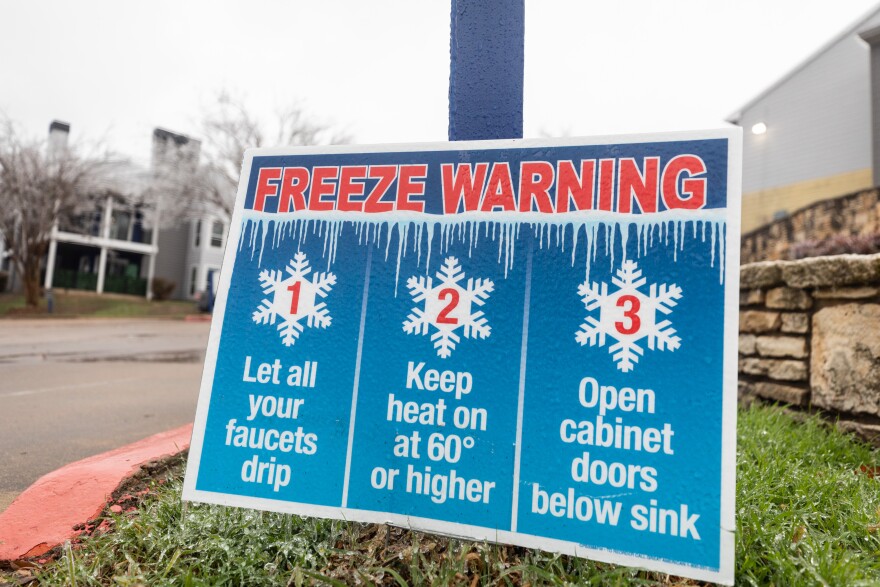Life Style
Freeze Warning Alerts In United States
Published
6 months agoon
By
admin
Are you prepared for the chilling arrival of winter? As temperatures drop and icy winds sweep across the country, it’s essential to stay informed about potential freeze warnings in your area.
Freeze warning alerts serve as an early warning system, notifying us of impending freezing temperatures that can wreak havoc on our plants and pipes.
We will delve into what exactly a freeze warning alert is, why it’s crucial to pay attention to them, how they differ from frost advisories, and most importantly, how you can prepare yourself and protect your assets during these bone-chilling events. So grab a cozy blanket and let’s dive right into the world of freeze warnings!
What is a Freeze Warning Alert?
A freeze warning alert is a weather advisory issued by the National Weather Service (NWS) to notify residents of impending freezing temperatures in their area.
It serves as an early warning system, giving people time to take necessary precautions and protect themselves and their belongings from the potential damage caused by extreme cold.
When a freeze warning is issued, it means that temperatures are expected to drop below 32 degrees Fahrenheit (0 degrees Celsius) within the next 24 hours.
This can pose significant risks for sensitive plants, agricultural crops, outdoor plumbing systems, and even pets or livestock exposed to the frigid air.
These alerts are typically communicated through various channels such as local news stations, weather apps, social media platforms, and emergency notification systems.
It’s crucial to pay attention to these warnings and stay informed about any updates or changes in your area’s weather conditions.
In short, a freeze warning alert acts as your trusty companion during wintertime – providing valuable information that empowers you to safeguard yourself and your property against the bone-chilling effects of freezing temperatures. Stay tuned for more insights on why these alerts are so important!
Why are Freeze Warning Alerts Important?
Freeze warning alerts play a crucial role in protecting both individuals and property from the potential damage that freezing temperatures can cause. These alerts serve as early notifications of impending cold weather conditions, allowing people to take necessary precautions.
Freeze warning alerts help safeguard our health and safety. Freezing temperatures can pose serious risks, especially for vulnerable populations such as children, the elderly, and those with underlying health conditions.
By being aware of freeze warnings, individuals can take appropriate measures to stay warm and avoid exposure to extreme cold.
Moreover, these alerts are essential for protecting our homes and infrastructure. Freezing temperatures can lead to frozen pipes that may burst and cause extensive water damage.
With advance notice through freeze warning alerts, homeowners can take preventive actions like insulating exposed pipes or leaving faucets dripping overnight.
Understanding the Difference between Frost Advisory and Freeze Warning
When it comes to weather alerts, it’s important to know the difference between a frost advisory and a freeze warning. While they both indicate cold temperatures, there are key distinctions that can help you prepare accordingly.
A frost advisory is issued when temperatures are expected to drop below freezing overnight. This means that conditions may be favorable for frost formation on surfaces such as car windshields or plants. It’s a heads-up to take precautions if you have sensitive vegetation or need to protect any outdoor items.
It is issued when temperatures will reach or fall below 32 degrees Fahrenheit for an extended period of time. This can pose a significant threat to crops, pipes, and even pets left outdoors without proper shelter.
Knowing these differences allows you to gauge the severity of the situation and make necessary preparations. Whether it’s covering plants with blankets or insulating exposed pipes, taking action ahead of time can save you from potential damage.
Remember, being aware of these alerts gives you valuable information about what Mother Nature has in store for your area – so stay tuned!
How to Prepare for a Freeze Warning
Preparing for a freeze warning is crucial to protect yourself, your property, and your plants from the potential damage caused by freezing temperatures. Here are some important steps you can take to be prepared:
1. Stay informed: Keep an eye on weather forecasts and pay attention to any freeze warnings issued for your area. This will help you know when to expect freezing temperatures and plan accordingly.
2. Protect outdoor pipes: Insulate exposed outdoor pipes with pipe sleeves or wrap them in towels or blankets. Disconnect hoses from outdoor faucets and drain any remaining water to prevent them from freezing and bursting.
3. Cover vulnerable plants: Use frost blankets, old bed sheets, or even plastic tarps to cover delicate plants that are susceptible to cold temperatures. Secure the covers firmly around the base of the plant to trap heat and protect against frost damage.
4. Bring sensitive plants indoors: If possible, bring potted plants indoors where they can be sheltered from freezing temperatures.
5. Prepare emergency supplies: Have a supply of extra blankets, warm clothing, flashlights with fresh batteries, non-perishable food items, bottled water, and necessary medications ready in case of power outages or other emergencies during a freeze event.
6. Take precautions inside your home: Open kitchen cabinet doors under sinks located on exterior walls to allow warm air circulation around pipes; this helps prevent them from freezing.
By following these simple steps and being proactive in preparing for a freeze warning alert, you can minimize potential damage and ensure that you stay safe during cold weather episodes.
Tips for Protecting Plants and Pipes during a Freeze
When a freeze warning is issued, it’s crucial to take steps to protect your plants and pipes from the potential damage they can cause. Here are some tips to help you safeguard your outdoor investments:
1. Bring potted plants indoors: If you have potted plants that are susceptible to freezing temperatures, such as delicate flowers or tropical plants, bring them inside until the freeze has passed.
2. Cover sensitive plants: For larger outdoor plants that cannot be moved indoors, cover them with blankets or frost cloth. This extra layer of insulation can help shield them from the cold air.
3. Water before the freeze: Wet soil holds heat better than dry soil, so make sure to water your garden and flower beds thoroughly before a freeze hits.
4. Mulch around plant bases: Adding mulch around the base of your plants can provide an additional layer of protection by helping to retain heat in the soil.
5. Insulate exposed pipes: To prevent frozen and burst pipes, insulate any exposed plumbing in unheated areas such as basements, garages, or crawl spaces using foam pipe insulation sleeves or heat tape.
6. Drip faucets: Allowing faucets connected to vulnerable pipes running through exterior walls or unheated areas to drip slightly can relieve pressure and help prevent bursts.
7. Disconnect outdoor hoses: Ensure all garden hoses are disconnected from outside faucets and drained properly before a freeze arrives.
By following these precautions and staying vigilant during freeze warnings, you can significantly reduce the risk of damage caused by freezing temperatures both inside and outside your home!
Remember that every region may have different recommendations for protecting against freezes based on local climate conditions – be sure to consult with local gardening experts for specific advice tailored to your area!
Stay informed about upcoming weather patterns so you’ll always be prepared when a freeze warning comes your way!
Read more:Post Star Complete Guide

You may like

In the Spotlight: Sabu Howard’s Biography, and Net Worth

The Rise of Uber Trujillo: Griselda Blanco’s Legacy Lives On

Yasin Cengiz: Choreographing Stardom in the TikTok Spotlight

The Secrets of Dallas Yocum Unveiled

The Journey of Liam Costner: A Rising Star

Albert Ezerzer: What Really Happened Behind the Scenes?

Snake Oil Provisions | Remedy for the Mundane

Vintage Americana : RRL Jackets, Shirts, Clothing & Accessories

Intricate Links Unraveling NYT Connections Puzzle

Imgsed Imginn : Browse Instagram Incognito – The New Era of Social Media Privacy

How to Style Different Types of Shoes for Every Occasion

Personalized Concierge Medical Care in Santa Rosa

Difference Between Server vs. Cloud: Pick the Right Solution

VAIDYAGRAMA WELLNESS HOSPITAL

AUTO BODY REPAIR

Crafting Memories in Wood: The Timeless Allure of Wooden Caskets

7 Must-Know Insights on Quince Clothing for Your Special Day

Exploring the Craftsmanship of Treehouse Brewery A Haven for Beer Enthusiasts

The Ultimate Guide to Guns International

7 Must-Know Tips for Mastering Craigslist Palm Springs

In the Spotlight: Sabu Howard’s Biography, and Net Worth

The Rise of Uber Trujillo: Griselda Blanco’s Legacy Lives On

Yasin Cengiz: Choreographing Stardom in the TikTok Spotlight

The Secrets of Dallas Yocum Unveiled

The Journey of Liam Costner: A Rising Star

Albert Ezerzer: What Really Happened Behind the Scenes?

Snake Oil Provisions | Remedy for the Mundane

Vintage Americana : RRL Jackets, Shirts, Clothing & Accessories

Intricate Links Unraveling NYT Connections Puzzle





